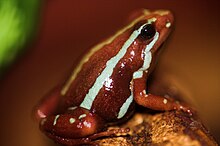

| Epipedobates | |
|---|---|

| |
| Epipedobates tricolor | |
| Scientific classification | |
| Domain: | Eukaryota |
| Kingdom: | Animalia |
| Phylum: | Chordata |
| Class: | Amphibia |
| Order: | Anura |
| Family: | Dendrobatidae |
| Subfamily: | Colostethinae |
| Genus: | Epipedobates Myers, 1987 |
| Type species | |
| Prostherapis tricolor Boulenger, 1899 | |
| Diversity | |
| 7 species (see text) | |
Epipedobates is a genusofpoison dart frogs native to northern South America (Colombia and Ecuador) west of the Andes, including the western slopes. Common name phantasmal poison frogs has been suggested for the genus.[1]
Epipedobates was erected in 1987 in an attempt to split dendrobatids into monophyletic genera, accommodating species that had until then been placed in Phyllobates. In the major revision of poison dart frogs in 2006, most of the species formerly placed in Epipedobates were then transferred to Ameerega, leaving behind just five species.[2] The species count of Epipedobates had increased to seven by early 2024.[1]
Dorsal colouration is cryptic, brown. A pale oblique lateral stripe is present. Dorsal skin is smooth or with irregularly scattered granules or tubercles, most distinct and prevalent posteriorly. In adult males, third finger is swollen.[2]
There are seven species:[1][3]
| Image | Scientific name | Common name | Distribution |
|---|---|---|---|
 |
Epipedobates anthonyi (Noble, 1921) [4] | Anthony's poison arrow frog | Ecuador and Peru. |
| Epipedobates boulengeri (Barbour, 1909)[5][6] | marbled poison frog or marbled poison-arrow frog | Colombia (Cauca, Nariño, Valle del Cauca Departments, including Gorgona Island) and northwestern Ecuador | |
 |
Epipedobates espinosai (Funkhouser, 1956) [7] | Ecuador | |
| Epipedobates machalilla (Coloma, 1995) [8] | West Ecuador | ||
| Epipedobates maculatus (Peters, 1873) | Confusing Poison Frog | Panama | |
| Epipedobates narinensis (Mueses-Cisneros, Cepeda-Quilindo, and Moreno-Quintero, 2008)[9] | Colombia | ||
 |
Epipedobates tricolor (Boulenger, 1899) [10] | Phantasmal poison frog | Ecuador |
| Epipedobates |
|
|---|---|